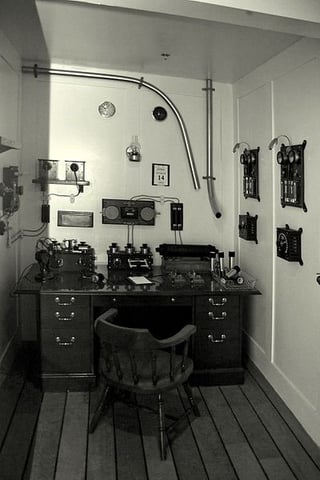Prior to the 1800s, ocean-going vessels were focused on the hauling of cargo or used as warships rather than for passengers leisurely traveling from country to country. The first shipping company to offer regularly scheduled service from the U.S. to England, and to be concerned with the comfort of their passengers, was the Black Ball Line in New York in 1818. By the 1850s, a dramatic improvement in the quality of a passenger’s voyage occurred with ships adding luxuries like electric lights, more desk space and entertainment — ultimately, founding the cruising industry as we know it today.

One major concern for traveling by sea during war, hauling cargo or carrying passengers, was the ability to communicate between ships and from ship to shore. In the 1800s, the British Royal Navy started working with ideas from Heinrich Hertz on electromagnetic radiation and scientists such as Guglielmo Marconi to use radio waves to communicate utilizing Morse code, a telegraph system to transmit information over wires. By the early 1990s, the Royal Navy started to adopt transmitters fitted with alternators and used magnetic detectors with headphones to properly communicate between ships and shore. Companies like The White Star Line, which was owned by J.P. Morgan and introduced the most luxurious passenger ships ever seen with the Olympic and Titanic, followed suit in utilizing a Marconi apparatus for communications during its ships’ voyages. With the devastating sinking of the “unsinkable” cruise ship in 1912, wireless communications underwent major changes and became the subject of regulatory reviews covering a range of maritime practices. One item of this wide-ranging legislation mandated that wireless reception on ships should be operated 24 hours a day for continuous monitoring of distress calls — a key importance that wireless could have in saving lives when at sea. Also, it’s notably still in place today.
Marconi apparatus utilized on the Titanic
After the discovery of microwaves in 1931, the U.S. Navy postulated that they could bounce these waves off the surface of the Moon, the Earth’s natural satellite, allowing them to send information to the other side of the world with much less interference. In 1957, the Soviet Union sent Sputnik, the first artificial satellite to contain a radio transmitter up into space; and the U.S. followed soon after. This “spacerace” led to more efficient communications systems that continue to be used and perfected to this day throughout the maritime industry. Soon after, the world’s first Ku-band Very Small Aperture Terminal (VSAT) systems were developed in 1985, making real-time broadband communications more seamless.
While the updated technology has made communications easier, it’s not been without its own complications and interference. A few major issues that occurred and are still pressing problems today include high costs, a small amount of bandwidth availability, potential downtime because of the lack of availability, speediness to generate more bandwidth, and the interference that can occur between satellites and antennas located on a ship depending on the location of the satellite in Earth’s atmosphere. With all of this, Speedcast has been strategically researching, planning and implementing a new solution to ease these issues and bring the cruising experience into the 21st century.
